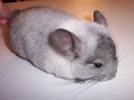Welcome To Kuby's Kritters
Home Page
Welcome to Kuby's Kritters. We are owned and operated out of Buffalo, NY. I have owned chinchillas for about 10 years now and just began a breeding program a few years ago with the help of Missi from Cedar River Chins. Missi has helped explain the ins and outs of the chin world, shows, and helped me build what I think is a phenomenol starter herd. All of my breeding animals come from high quality stock. We have animals from Ryersons Chinchilla Ranch, Cedar River Chins, Silkreheins, White woods, Shoots, Chinchilla Park Place to name a few. I am currently breeding Standard, Black Velvet, White Mosaic, Beige, and Ebony.
Chinchillas
Chinchillas are rodents, native to the Andes. In the late 18th and early 19th century, chinchillas were massively hunted and trapped for their fur. The skins were shipped by the bale to Europe and United States. Owning a chinchilla fur coat became a must for the royalties and well-to-do families. This activity led to the near extinction of the animal. In 1923, Mathias F. Chapman, an US engineer, captured eleven chinchillas and shipped them to the US for breeding purposes. These eleven chinchillas were the foundation stock of the chinchilla farms today. Chinchillas are bred for various purposes: as pet, for their fur, as a breeding stock, etc.
There are different types of Chinchillas, namely Lanigera, Costina and Brevicaulda. Most chinchillas come from Lanigera. The other types come about due to the effort of breeders and natural mutations. Some said that Costina and Brevicaulda are Lanigera that adapted to different altitudes. Lanigera It has straight, blunt nose with medium size ears and long tail. Brevicaulda It is larger and more chunky than Lanigera. It has blunt nose with short round ears and tail. Costina This is smaller and slimmer than Lanigera. It has a narrow and rat-like nose with bigger ears and longer tail. Through careful and selective breeding, there are many mutations available today. They are a very hardy animal and can live for up to 15 to 20 years in captivity.
Females can have up to 3 litters of kits each year when they become of breeding age. The gestation period for Chinchillas is approximately 111 days. The average birth weight of the kits can range anywhere from 40 grams to 70 grams. It is advised to remove the male after the female has completed giving birth to prevent a breedback. Most Chinchilla moms do not require assistance giving birth, or taking care of the kits. There are times when you may have to intervene and assist mom. It is my suggestion that you not jump into breeding before knowing the facts. A very wise breeder told me once, that you never stop learning, and this I have found to be true.
Chinchilla pellets are considered to be the best type of food concentrate, but they must be of good quality and fed fresh so the vitamin content isn't expired with age.
In addition to the pellets, it is essential that a chinchilla eats a good handful of good quality of hay daily. Hay is the main source of fiber in a chinchillas diet. It should be of good quality, sweet smelling, and definitely not mouldy, damp or dusty. Out of choice, we give our chinchillas fresh alfalfa hay cubes and every other day they get a handful of loose timothy hay. Nursing mothers get loose hay every day for them and the new kits.
We also feed Ryerson Suppliment to all our chins each evening. The chins love the supplement and many of them will bang their supplement dishes in anticipation of getting the supplement.
I hope you enjoy our site, and feel free to email us with any questions you might have. Thank you.
